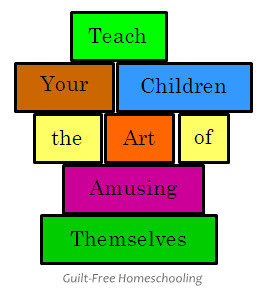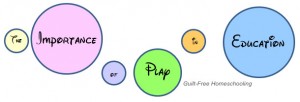My view of academics and education changed significantly throughout my years as a homeschool teacher. Once upon a time, I thought of education as something that ended with 12th grade graduation or was extended by some people with a foray into college. During my stint in college, there was an older gentleman whom we younger students joked about as being a “professional student” because he had been taking a class or two each semester for years. I did not realize then that education could be a lifelong endeavor; I just assumed he did not know what he wanted to be when he grew up. Now I can look back at my foolish naivete’ and be grateful that maturity eventually replaces youthful ignorance and its accompanying arrogance.
Education is merely the process of learning, and I continue to learn every day. Learning is learning, whether one is studying a foreign language or making a mental note to avoid the pothole down the block. Learning is the reason why we read the newspaper or watch the local weather forecast on television. We become more educated when we try a new recipe: at the very least, we learn whether or not we want to make that recipe again. Learning, education, and academics take on new, more personal meanings with the advent of homeschooling.
Legal homeschooling in our state required that we submit documents annually to the state Department of Education. One form had boxes to check to indicate your students’ participation in various extra-curricular activities. At first, I viewed those activities in much the same straightforward way that any other educator would. After a few years of homeschooling, however, my viewpoint had shifted, and I began to see things a bit differently — from a homeschooler’s point of view.
Regular library visits? Well, we had never experienced an irregular visit, no matter how infrequently they occurred, so, yes, we planned regular library visits.
Field trips? Yes, we participated in field trips, whether to the grocery store or with more structured, group activities.
Music lessons? Yes, group singing would be taking place at church. There would also be the intermittent “Happy Birthday” choruses and Christmas carols, singing along with children’s videos, banging on the pots and pans, and singing the latest catchy advertising jingles. (It does not have to cost money to be a real lesson.)
Sports activities? Most definitely! You cannot make these children sit still for long! I did not see this as requiring us to join the local soccer club; to me, it could also mean playing horsey with Dad, riding your bike, or splashing in the wading pool — getting off of the sofa and out of the house.
Other planned social experiences? This must have been listed just to satisfy those weirdos who think that homeschoolers never leave the house, but, yes, we did plan to experience society from time to time, and Wal-Mart was typically a melting pot of society in our community.
Another required document was our “plan” for the year’s lessons. I learned to view that with the same earnestness with which I viewed preparation time for dinner each night: we would eat dinner each night, so therefore there would be some type of preparation for it. One night’s dinner may require several hours of hands-on preparation, while another night’s meal may only require phoning the pizza delivery guy. Either way, we ate. Similarly, some lessons received intensive, hands-on preparation, and others were delivered by flipping open a book, but either way, we learned. My Plan of Instruction did not list detailed lesson plans, but did list the approximate amount of time each student would spend per day on each subject (per week for lower grades). [See also Guilt-Free Lesson Plans and Scheduling] If we spent more time or less time on any certain area on any certain day, what did it matter? Some lessons were fast-food snacks, and other lessons were seven-course-meal events. The learning itself was what mattered, not the speed of the delivery, and there were many times when we learned more from the spontaneous, quick-snack lessons than we did from the this-took-me-all-day-to-prepare lessons.
Information of academic importance obviously means different things to different people. Another mandate on our annual report stated that a revised form was to be filed if any of the listed information changed during the year. Throughout the years that my children were enrolled in public school, we were rarely informed of changes to the routine, including some important changes in the staff. After we had been homeschooling for a few years, we were (again) not notified when the district’s Homeschooling Coordinator left on a two-week vacation, leaving a letter of resignation and two weeks’ notice on her desk, a gaping hole in the district’s staff, and many confused families in a state somewhere between shock and limbo — during the busiest time for the district office, the month before the fall semester began. Therefore, based on their precedent, I concluded that most of the changes I could make to our plans would be of minor significance to the district, and I switched textbooks and materials whenever I felt the need to do so, Guilt-Free, without bothering to inform them of such trivial details.
My view of the ideal teaching methods for individual subjects also changed. Once my students were reading well on their own, I allowed their “reading” course to be done in bed at night as a “decompression” time before Lights Out. I found that I was able to monitor their reading ability in their other subjects well enough that I no longer bothered to keep track of their personal, pleasure reading for a “reading class.”
Education, learning, and academics mean different things to different people. “Professional” educators view learning as an activity that takes place under their highly trained supervision. I, as a homeschool educator, see learning as more of a 24 hours a day, 7 days a week pursuit. We do not always need books or plans or even a stone-faced serious attitude in order to come away from something as a smarter person. Education and learning can and do take place in the garage or on the playground, while doing chores or while having fun, early in the morning or late into the night. Education is the process of learning. Learn something every day.





 Guilt-Free Homeschooling is the creation of Carolyn Morrison and her daughter, Jennifer Leonhard. After serious disappointments with public school, Carolyn spent the next 11 years homeschooling her two children, from elementary to high school graduation and college admission. Refusing to force new homeschooling families to re-invent the wheel, Carolyn and Jennifer now share their encouragement, support, tips, and tricks, filling their blog with "all the answers we were looking for as a new-to-homeschooling family" and making this website a valuable resource for parents, not just a daily journal. Guilt-Free Homeschooling -- Equipping Parents for Homeschooling Success!
Guilt-Free Homeschooling is the creation of Carolyn Morrison and her daughter, Jennifer Leonhard. After serious disappointments with public school, Carolyn spent the next 11 years homeschooling her two children, from elementary to high school graduation and college admission. Refusing to force new homeschooling families to re-invent the wheel, Carolyn and Jennifer now share their encouragement, support, tips, and tricks, filling their blog with "all the answers we were looking for as a new-to-homeschooling family" and making this website a valuable resource for parents, not just a daily journal. Guilt-Free Homeschooling -- Equipping Parents for Homeschooling Success!

Recent Comments